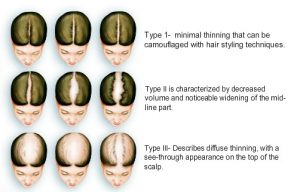About Hair Gro Therapy
Order And Delivery
Hair Loss in Women
Hereditary
Androgenetic Alopecia, or Female Pattern Hair Loss, is a hereditary condition that shortens the lifecycle of hair. Androgenetic Alopecia causes the hair follicles to become smaller, eventually leading to thinner, and light coloured hair. In Female Pattern Hair Loss, the most extensive hair loss happens on the top of the head.
After Pregnancy
During Pregnancy, women’s hairs are much fuller and thicker. It is after giving birth that women suffer from hair loss. It is a common occurrence for hair to fall in large quantity, however, once the women’s body returns to the pre-pregnancy stage, hair growth returns to normal.
Birth Control
Though birth control prevents pregnancy, the pills have a lot of side effects. One of the side effects of using birth control is thinning of hair and hair fall. Some women have also reported hair loss after they stop taking the pill. Hair loss with birth control usually happens to women who are sensitive to the hormones that are in the pill and who have a history of hormone-related hair loss. The pill moves the hair from its growing phase into its resting phase faster than usual. Hair loss of this form is called Telogen Effluvium. Birth control related hair loss is temporary and should stop once the body gets used to the pill.
Other birth control methods that cause hair loss in women are:
Vaginal Rings
Hormonal Injections
Skin Patches
Progestin Implants
Telogen Effluvium
Telogen Effluvium is temporary hair loss which happens if you are undergoing stress, hormonal imbalance, diet, or a traumatic event. During this time the hair follicles are in a resting phase and result in an increase in hair fall and temporary loss of hair across the scalp. Once the cause has been corrected, hair growth should return to normal.[/vc_column_text][/trx_accordion_item][trx_accordion_item title=”Whom to blame for hair loss?”][vc_column_text]Women can inherit hair loss DNA from either parents or one of them, though it is a myth that genetic hair loss is inherited from only one side of the family. The chances of a woman experiencing hair loss increases if she has close relatives who suffer from hair loss.[/vc_column_text][/trx_accordion_item][trx_accordion_item title=”What is the difference in hair loss pattern between men and women?”][vc_column_text]Women are inclined towards losing hair on the top of the head in a dispersed pattern which is often noticeable as a wide parting. Whereas in men, hair loss is a receding pattern and around the crown of the head.[/vc_column_text][/trx_accordion_item][trx_accordion_item title=”Do only older women experience hair loss?” id=”sc_accordion_item_1507889600835_3″][vc_column_text]Hair loss can begin as early as being in your 20s. It is more common in women in their 30s and approaching and going through menopause.[/vc_column_text][/trx_accordion_item][trx_accordion_item title=”What does Female Pattern Hair Loss look like?” id=”sc_accordion_item_1507889703355_6″][vc_column_text]You know you suffer from Female Pattern Hair Loss if you start to see a widening part. This is how it would look like:

Female Pattern Hair Loss
There are several causes of hair loss in women, but the most common of them is Female Pattern Hair Loss or Androgenetic Alopecia (AGA). Age, Hormones, Genetics can change the hair follicles which lead to the condition of AGA.
Your Family History
Look back on your family history and see which of your close relatives suffer from balding and hair thinning. Hair loss can be inherited from either parent or both, so if you have hair thinning in your family; you are most likely to get that gene.
Check your Parting
Hair loss in women mainly occurs on the top of the head and is very visible in the parting area. The parting is the first thing that changes when you have massive hair fall. So if you have started to notice that your parting is widening and you don’t have enough hair to cover it, it’s time to pay attention to it.
Make a hair fall tracking diary
Over a course of one to two months track, how much hair are you losing and in what quantity? Make a note of when are you losing hair the most, is it while showering or brushing your hair. Discuss this with your hair specialist.
Gather Evidence
Bring together all the evidence you can to your specialist. It will make it easier for them to test your hair and accordingly recommend the treatment you need. Make a note of all the tests and treatments you have done and the results you have achieved. Note all the ingredients in each test. Take some pictures of your scalp to your specialist and if you are not shy take some fallen strands along.
Inform about your lifestyle
There are plenty of causes for hair loss in women, not just genetics. Your lifestyle is equally responsible for hair loss. Whether you are stressed, going through some trauma or shock, medical condition all lead to hair loss. Do inform your specialist in detail and also the medicines you are taking if any, including birth control.
Test hair if necessary
Your hair specialist will ask more questions regarding your medical history as well as your family’s. So go prepared with all the details. Ask if further tests are required and the procedure.
Hair Loss in Men
It pattern begins from the temples and vertex of the scalp and the hairline progressively recedes backwards.
Alopecia Areata – Alopecia Areata is characterized by sudden bald patches. In some extreme cases, it can lead to complete hair loss. The condition can appear anywhere on the head and is often circular.
Alopecia Totalis – Alopecia Totalis is an autoimmune condition that turns the immune system against the hair follicles. It results in total hair loss on the scalp and can also affect eyelashes and eyebrows.
Telogen Effluvium – In this condition hair loss is caused if you are under severe stress or shock. It leads to hair thinning and patches of thin hair. Hair starts to grow again once the shock and stress are controlled.
Tight Hairstyles – Tight ponytails, man buns, the combed back look, dreadlocks, and other styles can all cause stress to the hair making it weak overtime resulting in hair loss.
Thyroid – The long-term symptom of suffering from Thyroid problems is hair loss. When the thyroid is underactive, it can lead to some medical conditions.
Infections – Ringworm is one of the infections associated with hair loss. Ringworm is a fungus that grows on the scalp and other body parts. It forces the hair to fall in patches. Other infections include Dermatitis, which is mainly a skin condition, Folliculitis, which cause inflammation of the hair follicles and Syphilis, which is a sexually transmitted disease that can cause hair to thin and turn brittle.
Diet – Poor diet can lead to unhealthy hair and poor hair quality. Hair is made of protein; if there is no protein in your diet, it can affect the hair growth.
Smoking – Smoking can cause hair loss. Cigarette smoke contains toxins that cause damage to the hair follicle DNA. The smoke leads to follicular micro-inflammation and fibrosis and impaired blood flow. This disrupts the normal growth cycle and in turn, results in hair thinning and loss.
Drugs and Medication – Most medications have side effects of one form or the other, and one of them is hair loss. Anti-depressants, Excessive Vitamin A, medicines for blood thinning, steroids, hormonal medications like testosterone can all lead to hair loss and hair thinning.
For Expert Call related to product contact us on : 9222220003 / 9222220004
